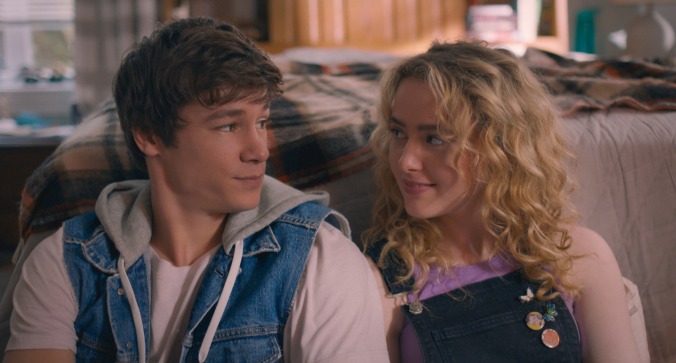Help! We’re trapped in the cycle of yet another time-loop story, The Map Of Tiny Perfect Things


Every day is exactly the same. That’s how it goes in time-loop stories, and how it can feel to write about them, too. Eventually, you become trapped in your own loop, repeating yourself again and again. Call it the Groundhog Day of critic beats: How many different ways are there to say that Bill Murray perfected this premise already? You can focus on the actors, the genre accent, the astro this or anomalous that. You can mention whether the characters mention Groundhog Day. But at a certain point, you’re just running down a list of memorized patterns, like poor Phil Connors and every other broken-clock sucker to come after him. To amuse yourself, maybe you reach for a gimmick…
Every day is exactly the same. That’s how it goes in time-loop stories, and how it can feel to write about them, too. It’s impossible not to experience déjà vu when confronted with a minor variation like The Map Of Tiny Perfect Things. Based on a short story by Lev Grossman, author of the Magicians series, the film pairs off two bright, eloquent high school kids trapped in the purgatory of a day that keeps restarting. A coat of wholesome teen-lit charm has been slathered over the same ol’ plot with its same ol’ beats and same ol’ lessons. That the temporally screwed are teenagers isn’t a new wrinkle. Nor is the fact that there are two of them, or even that the movie begins, as an early draft of Groundhog Day did, with its hero already stuck in time. (Palm Springs, which was inspired enough in its repetitions to feel a little fresh, got there a year ago.)
Every day is exactly the same. That’s how it goes in time-loop stories, and how it can feel to write about them, too. The best you can hope for is to make your points with flair. Map has a little of that. Director Ian Samuels (Sierra Burgess Is A Loser) races through the first act of setup with the kind of punchy shorthand—relegating exposition to montage—that you’d want from a filmmaker borrowing a thoroughly over-borrowed scenario. His boy hero, Mark, is played by Kyle Allen, who’s like a slightly less… defined Ansel Elgort, and there’s an almost Baby Driver snap to the extended credits sequence, wherein the kid bikes and struts, entirely by memory, around the moving obstacles of his town, a place as cozy and sleepy and untouched by time as Punxsutawney.
Every day is exactly the same. That’s how it goes in time-loop stories, and how it can feel to write about them, too. Would quoting the dialogue distinguish this review from the last one? “I think it’s a metaphor for something,” Mark says about one screwball interaction he watches unfold every day or two; it’s among the more self-aware asides made by a character who name-checks not just Groundhog Day but also Edge Of Tomorrow when fruitlessly explaining his predicament. Grossman, adapting his own work, hands more knowing wit to Margaret (Kathryn Newton, possibly dry-running to a proposed Happy Death Day/Freaky crossover), who’s stranded on the same skipping record.
Every day is exactly the same. That’s how it goes in time-loop stories, and how it can feel to write about them, too. You start coming up with little exercises to vary the unvaried, which is what Mark and Margaret do in Map. The two cross paths and meet-cute during their umpteenth repeat, then devise a way to either kill time or, ideally, fix it: They’ll map their experience by witnessing every “perfect thing” that happens over 24 hours in their town. These include not just the occasional bit of chaos-theory slapstick involving a ricocheting tennis ball or unleashed dog but also plenty of Very Special Moments, as when a janitor takes a break from mopping the floor to play a few impeccable notes on a piano. If we all had the unlimited hours to study the world around us, maybe we’d discover how much it resembles a Hallmark card or Good Will Hunting.
Every day is exactly the same. That’s how it goes in time-loop stories, and how it can feel to write about them, too. The writers of these stories must also get bored. They keep trotting out the same lesson plan. Per Mark’s remarks, the mysterious time warp at the center of Map is a metaphor—it represents the anxiety some kids feel about the future’s approach. That’s why neither of the two prospective lovebirds seem tortured by their circumstances: They’re both secretly glad to be living life on pause. As thematic rationale for the Phil Connors condition goes, that’s fine. But the film adds hoary, sentimental lessons on top, forcing Mark to finally acknowledge that he’s not the center of the universe, even if his magical situation suggests otherwise. Margaret, meanwhile, has to learn to let go—a plot revelation so blatantly forecast, you’ll feel as five steps ahead of it all as Nadia Vulvokov or The Angel Of Verdun.
Every day is exactly the same. That’s how it goes in time-loop stories, and how it can feel to write about them, too. The same conclusion always presents itself: What made Groundhog Day special wasn’t just its premise but the fact that it was Bill Murray, filthy with deadpan personality, having his attitude cosmically adjusted. The Map Of Tiny Perfect Things wouldn’t fall anywhere near the bottom of a time-loop power ranking—it’s a divertingly fizzy bit of PG-13 puppy love. But its characters are basically stick figures of unblemished youth, pretty virtuous from the very start, and so their astrophysical dilemma never accumulates any dramatic or comedic urgency. Someone throw a wrench into the gears of this clockwork formula, or just retire it already! Movies shouldn’t feel like a day constantly resetting, all surprise and spontaneity zapped out of them by the thousandth cycle back around to the start.